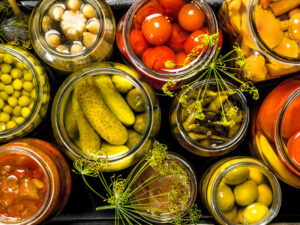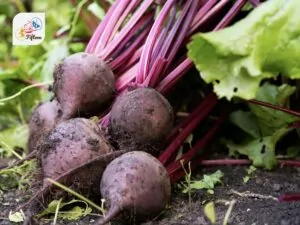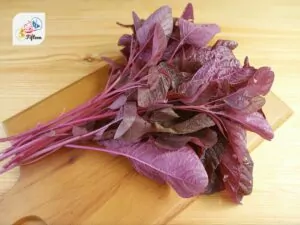Red vegetables are diverse produce characterized by their vibrant red color, ranging from deep crimson to bright scarlet. This striking hue is often due to the presence of pigments like lycopene and anthocyanins, which contribute to their vivid appearance.
Red vegetables are commonly used in various culinary applications, adding color, flavor, and nutritional value to dishes. They can be consumed raw, cooked, or incorporated into salads, soups, stews, and sauces.
Red vegetables’ natural sweetness and sometimes tangy flavor make them a versatile ingredient in both savory and sweet recipes.
Get ready to explore the top red vegetables in this read. Stick around till the end for some tasty cooking tips to retain the color of red veggies and a fun comparison of red and green veggies.
Let’s jump in!
Which Vegetables Are Red? Discover 14 Varieties in All Hues
Below are 14 red vegetables in every shade of red: from dark to light. You can use the filter to quickly find your favorite option.
Tomato
- For Dishes
Tomato is a fruit vegetable with smooth, glossy red skin and juicy, segmented flesh. With round or slightly oval shapes, the fruit has a mildly sweet and tangy flavor, often employed in various culinary uses.
This firm yet tender fruit laos has numerous small seeds embedded in the flesh. Tomatoes are commonly used in salads, sauces, soups, and stews, adding vibrant color and flavor.
They are also enjoyed fresh, sliced, or cooked in various dishes, providing a rich source of sweet and sour profile.
Beet
- For Dishes
Beet is a round or oval root vegetable with deep red or purple skin. Sported earthy flesh, beet provides a sweet, slightly earthy flavor and a firm, crisp texture when raw, becoming tender and smooth when cooked.
Furthermore, beets are common in salads, soups, and side dishes, often roasted, boiled, or pickled. Interestingly, the stalks growing from the beetroot are also edible, featuring a color just like the root’s inner content.
Red Cabbage
- For Dishes
Red cabbage is a leafy vegetable with tightly packed, deep purple or red leaves forming a round, dense head. The fresh cabbage leaves are slightly peppery and more robust than green cabbage, with a crisp texture when raw and tender when cooked.
This vibrant vegetable is often used in salads, slaws, and stir-fries, providing a splash of color. Additionally, red cabbage can be pickled, fermented into sauerkraut, or used as a flavorful side dish.
Radicchio
- For Dishes
Radicchio is another leafy green with vibrant red or purple leaves accompanied by white veins. These radicchio leaves are notably bitter and slightly spicy, often enjoyed crisp when raw.
Alternatively, cooked radicchio offers a more tender texture. Commonly used in salads, it contrasts bold colors and is best used when grilled, roasted, or sautéed.
Furthermore, cooking radicchio can reduce its bitterness and enhance its natural sweetness.
Radish
- For Dishes
- For Garnishes
Radish is a root vegetable known for its crisp texture and peppery flavor. Available in a round shape, the radish root has a smooth, red skin and white flesh that is crunchy when fresh.
Often used in salads, radishes have a sharp bite, perfect for pickled, roasted, or used as a garnish for various dishes.
Red Amaranth
- For Dishes
Red amaranth is favored for its vibrant red leaves and tender texture. The plant offers a mild, earthy flavor with a slightly sweet undertone.
The plants have striking red stems, leaves, and veins, perfect for use in salads, stir-fries, and soups. Also, red amaranth is a popular food source for people in North and Central America.
Red Bell Pepper
- For Dishes
Red bell pepper is known for its sweet, crisp flavor and vibrant color. The fruit has a smooth skin surface and a hollow interior filled with tiny seeds and a firm, crunchy texture.
Typically eaten raw in salads, sliced for snacks, or cooked in various dishes, red bell peppers add color and a peppery kick without including too much heat.
Rich in vitamins A and C, they are also used in stir-fries, roasted, or stuffed to create flavorful meals.
Red Carrot
- For Dishes
Red carrot is different from common carrot by its vibrant color, which indicates high levels of anthocyanins. This root vegetable offers a sweet, earthy flavor and a crisp, firm texture.
People tend to enjoy red carrots raw in salads or as a snack. Plus, red carrots can also be roasted, steamed, or added to soups and stews so they can soak up more flavor.
Red Chili Pepper
- For Dishes
- For Garnishes
Red chili pepper is known for its vibrant color and intense heat. The spicy flavor is a defining characteristic of ripe chilies, which have varying degrees of heat depending on the variety.
This small, elongated fruit vegetable has glossy skin and a firm texture. Often used fresh, dried, or ground into powder, red chili peppers are a staple in many cuisines for a fiery kick to dishes, from salsas and sauces to curries and marinades.
Red Onion
- For Dishes
Red onion is recognized for its mild, slightly sweet flavor, which intensifies when cooked. This round root vegetable has a distinctive reddish-purple skin and crisp, juicy layers that are slightly white.
Often used raw in salads and salsas for their sharp taste and vibrant color, red onions are also excellent when caramelized or roasted. They add a crunchy texture and a burst of color to dishes, making them a versatile ingredient in various culinary applications.
Red Spinach
- For Dishes
Red spinach is appreciated for its mildly sweet and earthy flavor, adding a unique twist to various dishes. Characterized by its vibrant red, this leafy vegetable is tender and delicate in texture.
Often used fresh in salads, it also retains its color and flavor when lightly sautéed or steamed. Red spinach is a colorful addition to meals, favored for its appealing color.
Red Potato
- For Dishes
Red potato is valued for its slightly sweet and creamy flavor. Known for its thin, red skin and firm, white flesh, this tuber holds its shape well during cooking.
These soft tubers are perfect for roasting, boiling, and salads, with smooth and consistent texture. Red potatoes are also a popular choice for grilling and mashing, offering a tasty, earthy taste.
Rhubarb
- For Dishes
Rhubarb is a crunchy vegetable with reddish-purple stalks of a tart flavor. This vegetable has long, thick stalks that range in color from green to deep red, while the texture is crisp and slightly fibrous.
When cooked, rhubarb becomes tender and releases its tangy juices, often sweetened with sugar. It is commonly used in jams, sauces, and baked goods, adding a unique, zesty taste to a variety of recipes.
Swiss Chard
- For Dishes
Swiss chard is known for its vibrant red, earthy flavor and versatility in cooking. With large, crinkly leaves and colorful stalks ranging from white to deep red, swiss chard adds visual appeal to dishes.
These leaves are also tender when cooked, while the stems remain slightly crunchy. Often used in sautés, soups, and salads, it provides a slightly bitter taste that mellows with cooking.
Which Cooking Methods Preserve the Color of Red Vegetables?
Preserving the vibrant color of red vegetables is key for their visual appeal and nutritional value. Here are 6 methods to help:

Blanching
Blanching briefly boils red vegetables, then cools them in ice water to keep their color. Ideal for bell peppers, tomatoes, and red cabbage, this method is great for Italian pasta, salads, and Asian stir-fries.

Roasting
Roasting brings natural sweetness and enhances red vegetables like bell peppers, beets, and tomatoes. Roasted red bell peppers are a staple in a range of Mediterranean dishes, while roasted beets feature prominently in European salads.

Grilling
Grilling can preserve the color, especially if done quickly. It’s ideal for red vegetables like bell, chili, tomatoes, and radicchio. In a collection of Mexican dishes, grilled red chili peppers add a fiery kick to salsas. Grilled red onions also enhance burgers and sandwiches worldwide.

Sautéing
Sautéing preserves the color and nutrients while adding a delicious caramelized flavor to red vegetables. Vegetables from Asia with red color, like red amaranth and red spinach are often sautéed with garlic and soy sauce.

Steaming
Steaming retains the nutrients and bright color of red potatoes, red carrots, and Swiss chard. Steamed red potatoes are a healthy side dish in American and British cuisines, while red carrots add a nutritious touch to meals.

Pickling
Pickling preserves the vibrant color and texture of radishes, red onions, and red chili peppers, infusing them with tangy flavors. This method is widely used in Korean kimchi and pickled radishes, Mexican pickled red onions, and a favorite Japanese dish – tsukemono.
After exploring the popular cooking methods to retain the red colors of vegetables, let’s explore whether red vegetables are better than green to help you choose the most suitable vegetables for your cooking needs.
Are Red Vegetables Better Than Green?
No, red vegetables are not necessarily better than green vegetables. Both red and green vegetables offer distinct nutritional benefits.
Red vegetables like tomatoes, red bell peppers, and beets are high in antioxidants such as lycopene and anthocyanins, which can help reduce the risk of certain cancers and support heart health. They also tend to be rich in vitamin C.
On the other hand, green veggies like spinach, kale, and broccoli are high in vitamins K, A, and C, and minerals like iron and calcium. They support digestive health, muscle function, and have cancer-preventing properties.
Consuming a variety of colorful vegetables is the best way to ensure a well-rounded intake of nutrients.
Ready to add more green goodness to your diet? Share your favorite green vegetable recipes in the comments, and don’t forget to check out our other articles on delicious and nutritious foods from around the world!

















Jamie Scott
Editor in Chief, Senior Content Writer
Expertise
Home Cooking, Meal Planning, Recipe Development, Baking and Pastry, Food Editor, Cooking-video Maker, Western Food Evaluation Expert
Education
Le Cordon Bleu College of Culinary Arts
Local Community College, New York, NY
Jamie Scott is a skilled culinary expert and content creator specializing in Western cuisine. With over 15 years in the culinary field and formal training from Le Cordon Bleu, Paris, Jamie deeply understands how to blend nutrition with delicious flavors. His passion for cooking matches his commitment to making healthy eating accessible and enjoyable.
On Fifteen.net, Jamie brings a fresh perspective to classic dishes and beverages, offering readers insightful recipes, cooking tips, and a fresh view on meal planning that emphasizes taste, health, and simplicity.